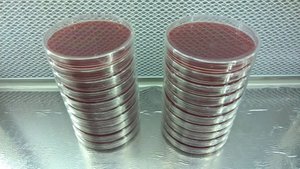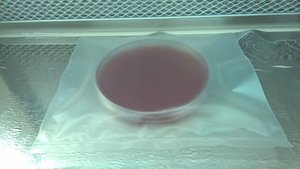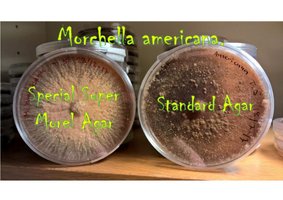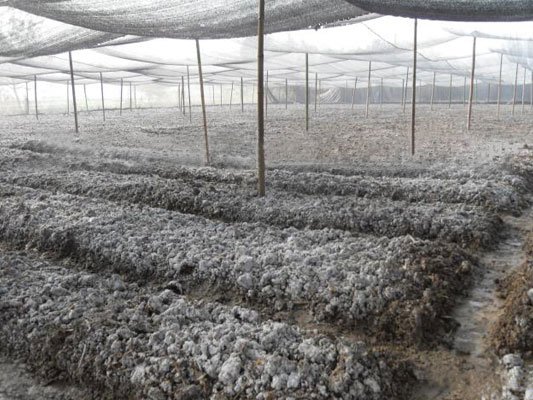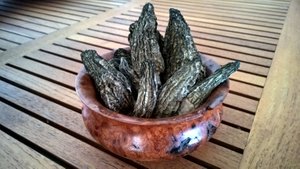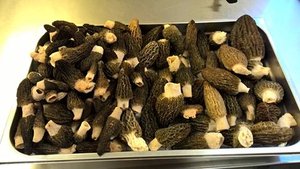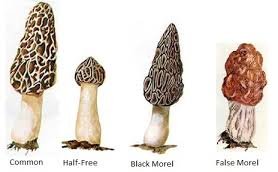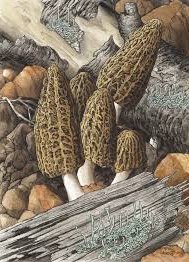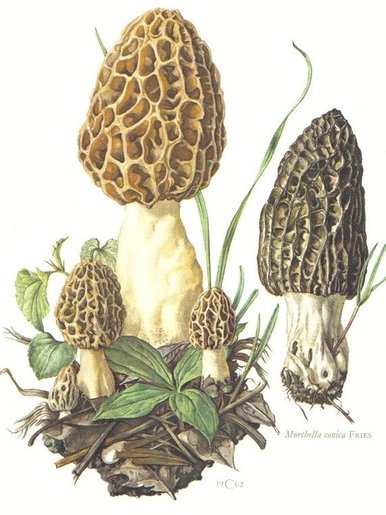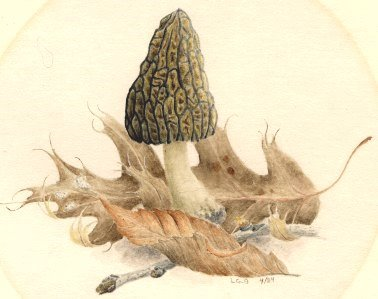Your outdoor adventure starts here
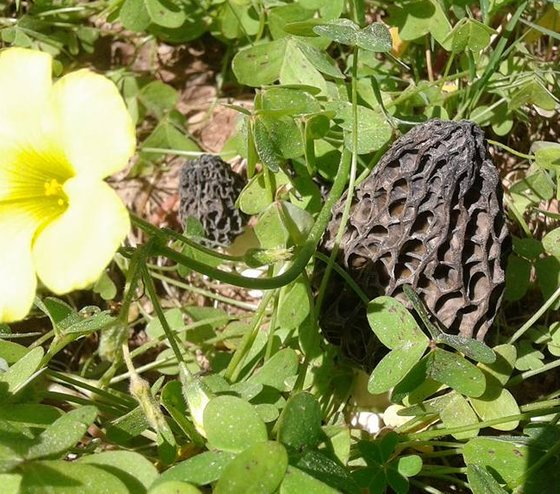
Morchella importuna . Spanish strain
A species of fungus in the family Morchellaceae described from North America in 2012. It occurs in gardens, woodchip beds, and other urban settings of northern Californiaand the Pacific Northwest region of the United States and Canada. The fungus has also been reported from Turkey, Spain, France, Switzerland, Denmark, UK, Germany, Sweden, Norway, Canada, China and many more, although it is unknown whether this is a result of accidental introductions. The fruit bodies develop a distinctive ladder-like pattern of pits and ridges on the surface of their conical caps.
The fruit bodies of M. importuna are 6–20 cm (2.4–7.9 in) high. The cap is 3–15 cm (1.2–5.9 in) high and measures 2–9 cm (0.8–3.5 in) wide at its widest point. It is conical to widely conical or occasionally egg-shaped. Its surface has pits and ridges, with 12–20 primary vertical ridges and numerous transecting horizontal ridges, creating a laddered appearance. The cap is attached to stipe with a sinus about 2–5 mm both deep and wide. The ridges are smooth or finely velvety and colored pale to dark gray when young, becoming dark grayish brown to nearly black in age. They are bluntly rounded when young, but later become sharpened or eroded. Pits are vertically elongated in all stages of development. They have a smooth or finely velvety texture. The pits open and deepen with development, progressing from gray to dark gray when immature to grayish brown, grayish olive or brownish yellow at maturity.
Since Morchella importuna is clearly a saprobe, at least most of the time, it may be a good candidate for cultivation
its cap portion contains isoleucine, leucine, lysine, methionine, phenylalanine, threonine, and valine 7 kinds of essential amino acids, Ganhan nontoxic, good stomach, phlegm qi efficacy. Morel nutrition very rich, it was determined, morel 20% crude protein, crude fat 26%, carbohydrates 38.1%, also contains a variety of amino acids, especially glutamic acid content of up to 1.76%. Therefore, it was considered to be "very good sources of protein," and a "prime in the dirty" reputation. The body of the protein is composed of 20 kinds of amino acids with and composed and morel it contains 18 species, including eight kinds of amino acids that the human body can not manufacture, but it is particularly important in human nutrition, so called "essential amino acids . "
at least eight kinds of vitamins: vitamin B1, vitamin B2, vitamin B12, niacin, pantothenic acid, topiramate hiccup alcohol, biotin, folic acid and so on. Morel nutrients can be comparable to milk, meat, and fish meal. Therefore, the international community is often called one of the "health food." Morel containing polysaccharide inhibition of tumor, anti-bacterial, anti-viral active ingredients, with enhanced immunity, anti-fatigue, anti-viral, tumor suppression and many other effects;
Morchella importuna. Danish strain
A species of fungus in the family Morchellaceae described from North America in 2012. It occurs in gardens, woodchip beds, and other urban settings of northern Californiaand the Pacific Northwest region of the United States and Canada. The fungus has also been reported from Turkey, Spain, France, Switzerland, Denmark, UK, Germany, Sweden, Norway, Canada, China and many more, although it is unknown whether this is a result of accidental introductions. The fruit bodies develop a distinctive ladder-like pattern of pits and ridges on the surface of their conical caps.
The fruit bodies of M. importuna are 6–20 cm (2.4–7.9 in) high. The cap is 3–15 cm (1.2–5.9 in) high and measures 2–9 cm (0.8–3.5 in) wide at its widest point. It is conical to widely conical or occasionally egg-shaped. Its surface has pits and ridges, with 12–20 primary vertical ridges and numerous transecting horizontal ridges, creating a laddered appearance. The cap is attached to stipe with a sinus about 2–5 mm both deep and wide. The ridges are smooth or finely velvety and colored pale to dark gray when young, becoming dark grayish brown to nearly black in age. They are bluntly rounded when young, but later become sharpened or eroded. Pits are vertically elongated in all stages of development. They have a smooth or finely velvety texture. The pits open and deepen with development, progressing from gray to dark gray when immature to grayish brown, grayish olive or brownish yellow at maturity.
Since Morchella importuna is clearly a saprobe, at least most of the time, it may be a good candidate for cultivation
its cap portion contains isoleucine, leucine, lysine, methionine, phenylalanine, threonine, and valine 7 kinds of essential amino acids, Ganhan nontoxic, good stomach, phlegm qi efficacy. Morel nutrition very rich, it was determined, morel 20% crude protein, crude fat 26%, carbohydrates 38.1%, also contains a variety of amino acids, especially glutamic acid content of up to 1.76%. Therefore, it was considered to be "very good sources of protein," and a "prime in the dirty" reputation. The body of the protein is composed of 20 kinds of amino acids with and composed and morel it contains 18 species, including eight kinds of amino acids that the human body can not manufacture, but it is particularly important in human nutrition, so called "essential amino acids . "
at least eight kinds of vitamins: vitamin B1, vitamin B2, vitamin B12, niacin, pantothenic acid, topiramate hiccup alcohol, biotin, folic acid and so on. Morel nutrients can be comparable to milk, meat, and fish meal. Therefore, the international community is often called one of the "health food." Morel containing polysaccharide inhibition of tumor, anti-bacterial, anti-viral active ingredients, with enhanced immunity, anti-fatigue, anti-viral, tumor suppression and many other effects;
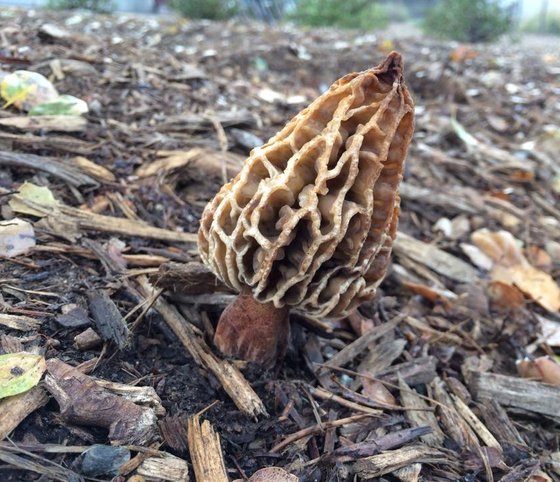
Morchella rufobrunnea.
commonly known as the blushing morel, is a species of ascomycete fungus in the family Morchellaceae. A choice edible species
M. rufobrunnea grows in disturbed soil or in woodchips used in landscaping, Reports from the Mediterranean under olive trees (Olea europaea), Young fruit bodies have conical, grayish caps covered with pale ridges and dark pits; mature specimens are yellowish to ochraceous-buff. The surface of the fruit body often bruises brownish orange to pinkish where it has been touched, a characteristic for which the fungus is named, the New Latin rufobrunnea signifying "rufus brown". M. rufobrunnea differs from other Morchella species by its urban or suburban habitat preferences, in the color and form of the fruit body, the lack of a sinus at the attachment of the cap with the stipe, the length of the pits on the surface, and the bruising reaction.
fruit bodies grow singly or in clusters in disturbed soil or woodchips used in landscaping. Large numbers can appear the year after wood mulch has been spread on the ground.Typical disturbed habitats include fire pits, near compost piles, logging roads, and dirt basements. Fruiting usually occurs in the spring, although fruit bodies can be found in these habitats most of the year. Other preferred habitats include steep slopes and plateaus, and old-growth conifer forests. In Cyprus, the fungus is frequently reported from coastal, urban and suburban areas under olive trees (Olea europaea).
ranges from Mexico through California and Oregon in the United States. It has also been introduced to central Michigan from California. It is one of seven Morchella species that have been recorded in Mexico. In 2009, researchers used molecular genetics to confirm the identity of the species in the mediterranean area, where it was found growing in gravelly disturbed soil. Unlike North American populations that typically fruit for only a few weeks in spring, the mediterranean (and Californian) populations have a long-season ecotype, fruiting from early November to late May (winter and spring). This period corresponds to the rainy season in Israel (October to May), with low to moderate temperatures ranging from 15–28 °C (59–82 °F) during the day and 5–15 °C (41–59 °F) at night.
Cap: 6-12 cm tall and 2-5 cm wide; conical or nearly so, especially in youth, but occasionally egg-shaped or nearly round; pitted and ridged, with the pits primarily arranged vertically, at least when young; when young with bluntly rounded to flattened, nearly white ridges and dark brown to black pits; when mature with sharpened or eroded, yellowish to brownish yellow pits and ridges; bruising salmon to orangish or reddish brown; completely attached to the stem; hollow.
Stem: 2-9 cm high and 1-2.5 cm wide; more or less equal, but sometimes swollen at the base; whitish to grayish, yellowish, or brownish; bruising orangish to rusty or reddish brown; bald or finely mealy with granules; hollow.
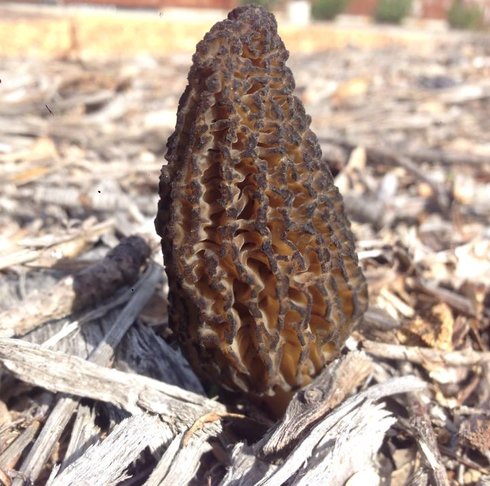
Morchella importuna. US strain.
A species of fungus in the family Morchellaceae described from North America in 2012. It occurs in gardens, woodchip beds, and other urban settings of northern Californiaand the Pacific Northwest region of the United States and Canada. The fungus has also been reported from Turkey, Spain, France, Switzerland, Denmark, UK, Germany, Sweden, Norway, Canada, China and many more, although it is unknown whether this is a result of accidental introductions. The fruit bodies develop a distinctive ladder-like pattern of pits and ridges on the surface of their conical caps.
The fruit bodies of M. importuna are 6–20 cm (2.4–7.9 in) high. The cap is 3–15 cm (1.2–5.9 in) high and measures 2–9 cm (0.8–3.5 in) wide at its widest point. It is conical to widely conical or occasionally egg-shaped. Its surface has pits and ridges, with 12–20 primary vertical ridges and numerous transecting horizontal ridges, creating a laddered appearance. The cap is attached to stipe with a sinus about 2–5 mm both deep and wide. The ridges are smooth or finely velvety and colored pale to dark gray when young, becoming dark grayish brown to nearly black in age. They are bluntly rounded when young, but later become sharpened or eroded. Pits are vertically elongated in all stages of development. They have a smooth or finely velvety texture. The pits open and deepen with development, progressing from gray to dark gray when immature to grayish brown, grayish olive or brownish yellow at maturity.
Since Morchella importuna is clearly a saprobe, at least most of the time, it may be a good candidate for cultivation
its cap portion contains isoleucine, leucine, lysine, methionine, phenylalanine, threonine, and valine 7 kinds of essential amino acids, Ganhan nontoxic, good stomach, phlegm qi efficacy. Morel nutrition very rich, it was determined, morel 20% crude protein, crude fat 26%, carbohydrates 38.1%, also contains a variety of amino acids, especially glutamic acid content of up to 1.76%. Therefore, it was considered to be "very good sources of protein," and a "prime in the dirty" reputation. The body of the protein is composed of 20 kinds of amino acids with and composed and morel it contains 18 species, including eight kinds of amino acids that the human body can not manufacture, but it is particularly important in human nutrition, so called "essential amino acids . "
at least eight kinds of vitamins: vitamin B1, vitamin B2, vitamin B12, niacin, pantothenic acid, topiramate hiccup alcohol, biotin, folic acid and so on. Morel nutrients can be comparable to milk, meat, and fish meal. Therefore, the international community is often called one of the "health food." Morel containing polysaccharide inhibition of tumor, anti-bacterial, anti-viral active ingredients, with enhanced immunity, anti-fatigue, anti-viral, tumor suppression and many other effects;
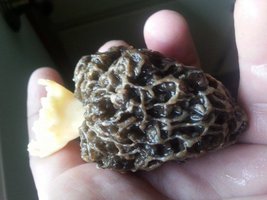
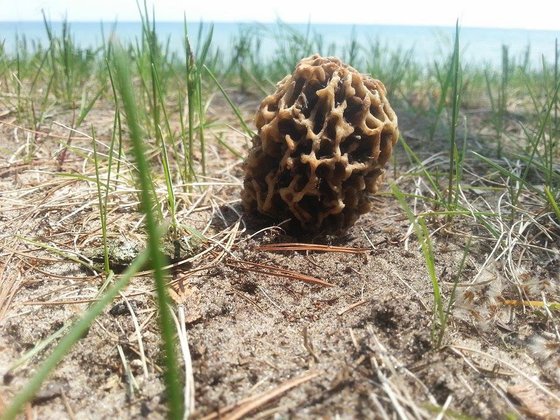
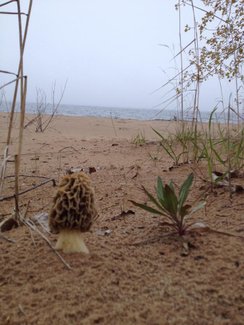
Morchella prava. American beach morel
A species of fungus in the Morchellaceae family described as new to science in 2012. It is found in the range 43–50°N across North America, where it fruits from April to June
Among the large yellow morels, this odd species looks like an irregular, deformed version of Morchella esculentoides or Morchella cryptica. Its pits are irregular in outline and in arrangement, and the mushroom generally has a gnarled-looking appearance. DNA-verified collections of Morchella prava have come from a wide variety of habitats, from mountain conifer forests to filled-in swimming pools . . . but most of the collections were made in sandy soil near rivers or lakes, under oaks and pines. The distribution of the species appears to be northern, from Montana to Ontario.
Ecology: Possibly saprobic and mycorrhizal at different points in its life cycle; growing alone, scattered, or gregariously under various hardwoods and conifers, often (but not always) in sandy soil near bodies of water (lakes, rivers); April, May, and June; apparently widely distributed in northern North America
Cap: 3-6 cm tall and 2-5 cm wide; irregularly shaped but often more or less egg-shaped with a slightly narrowed or widely conical apex; pitted and ridged, with the pits randomly arranged and oriented and irregular in outline; when young with bald or finely velvety, flattened or widely rounded, pale yellowish to whitish ridges and medium to dark gray or black pits; when mature with bluntly rounded to sharp or eroded, brownish yellow to yellowish brown ridges and similarly colored pits (but often remaining in the "gray stage" for a prolonged period and apparently never maturing); attached to the stem directly, without a groove; hollow.
Stem: 2.5-4 cm high and 1-3 cm wide; equal above a slightly swollen base; whitish to yellowish; often discoloring reddish brown; bald or nearly so; hollow.
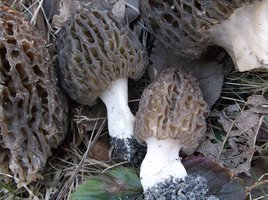
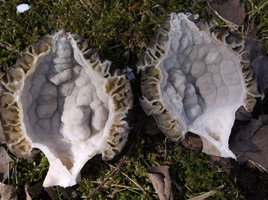
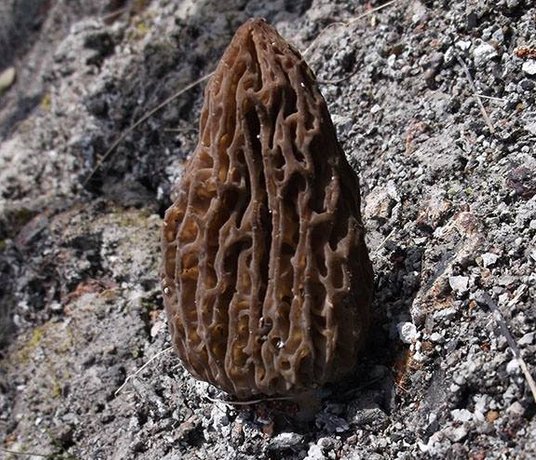
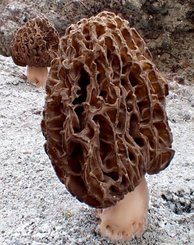
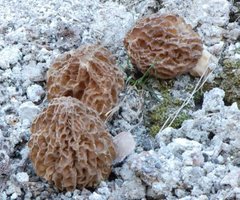
Morchella eohespera.
a species of fungus in the Morchellaceae family described as new to science in 2016. In North America, it has been collected from Newfoundland and Labrador, New Brunswickand Washington State. It is also found in central and northern Europe, and central China. It is in the Morchella elata clade.

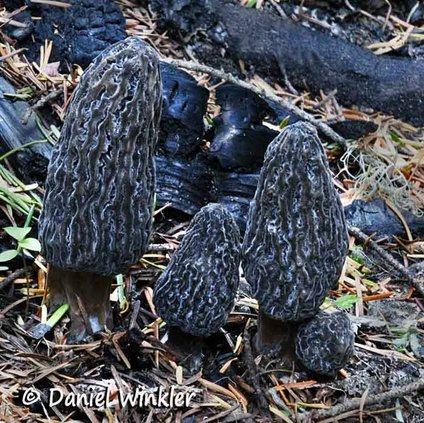
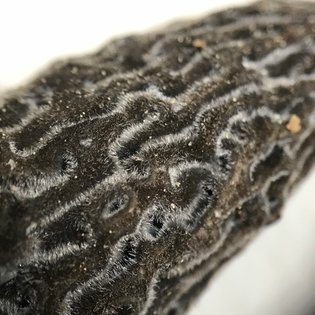
Morchella tomentosa
commonly called the gray, fuzzy foot, or black foot morel, is a fire-associated species described from western North America, formally described as new to science in 2008.
Morchella tomentosa is identified by its post-fire occurrence, fine hairs on the surface of young fruit bodies, and a thick, "double-walled" stem.[1][3] It also has unique sclerotia-like underground parts.[4] Color can range from black and "sooty" to gray, brown, yellow, or white, although color tends to progress from darker to lighter with age of the fruiting body
Based on studies of DNA, M. tomentosa is clearly a distinct species apart from the yellow morels (M. esculenta & ssp.) and black morels (M. elata & ssp.)
especially when it is exposed to direct sunlight. Thus, while young, black specimens are unmistakable, older specimens can look like several other types of morels,
Commercial mushroom collectors in the western mountains are very familiar with Morchella tomentosa, which they call the "gray morel" (not the same thing as the "gray morel" known to collectors in the Midwest and eastern North America, who use the term for immature forms of yellow morels like Morchella esculentoides).
Ecology: Possibly saprobic and mycorrhizal at different points in its life cycle; growing alone, scattered, or gregariously in burned conifer forests, primarily in the spring following the fire (but sometimes appearing in dwindling numbers for a few years thereafter); usually appearing at high elevation; spring (accounting for elevation); Colorado to northern California and Alaska.
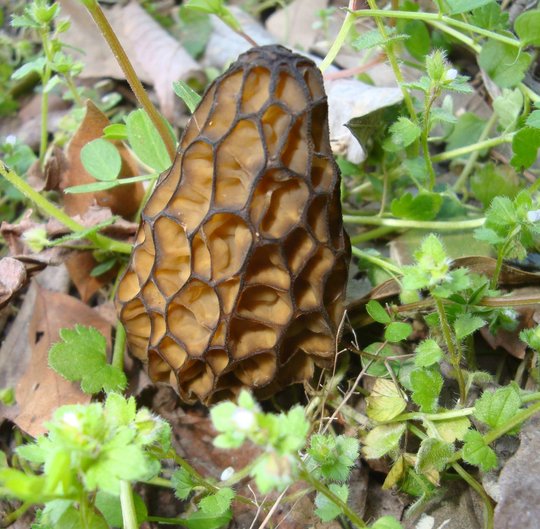
Morchella conica. japanese strain

Morchella americana.
a species of fungus in the Morchellaceae family native to North America. Described as new to science in 2012, it is common east of the Rocky Mountains in a range stretching from Ontario south to Texas, Arkansas and South Carolina. In western North America, the species typically is found under hardwood trees in river bottoms, or with apple trees or ornamental ashes in urban settings. The specific epithet americana refers to its occurrence in North America.
For more information see Morchella esculenta.

Morchella sextelata.
a species of ascomycete fungus in the family Morchellaceae. Described as new to science in 2012, it is found in North America (in Washington, Idaho, Montana, Wyoming, New Mexico, and Yukon Territory). It has also been found in China, although it is not known if this is a result of an accidental introduction or natural dispersion. The fruit bodies have a roughly conical cap up to 7.5 cm (3 in) tall and 5 cm (2 in) wide, with a surface of mostly vertically arranged pits. The cap is initially yellowish to brownish, but it darkens to become almost black in maturity. The stipe is white and hollow, measuring 2–5 cm (0.8–2.0 in) high by 1–2.2 cm (0.4–0.9 in) wide.
Morchella sextelata is one of four species of wildfire-adapted morels in western North America, the others being M. capitata, M. septimelata, and M. tomentosa.
They tend to appear in great numbers the year immediately following fire and appear in decreasing frequency in successive years. Fruiting occurs from April through July, at elevations between 1,000 and 1,500 m (3,300 and 4,900 ft). The distribution includes Washington, Idaho, Montana, Wyoming, and Yukon Territory.[1]M. sextelata has also been found in China, but it remains unclear whether dispersal between these distant locations occurred naturally or through accidental introduction by humans.
Morchella sextelata, identified as phylogenetic species "Mel-6", has been shown to colonize the non-native species Bromus tectorum (cheatgrass) as an endophyte, increasing the overall growth of the grass, as well as the abundance of seeds and their tolerance to extreme heat (60–65 °C (140–149 °F)). This has been hypothesized to be a contributing factor in the success of cheatgrass as an invasive species in western North America.
The fruit bodies of Morchella sextelata are 4–10.5 cm (1.6–4.1 in) high with a conical cap that is 2.5–7.5 cm (1.0–3.0 in) high and 2–5 cm (0.8–2.0 in) wide at the widest point. The cap surface features pits and ridges, formed by the intersection of 12–20 primary vertical ridges and frequent shorter, secondary vertical ridges, with occasional sunken, horizontal ridges. The cap is attached to the stipe with a sinus about 2–4 mm deep and 2–4 mm wide. The ridges are smooth or very finely tomentose (covered with densely matted filaments). They are initially colorless, becoming pale tan, then dark grayish brown in maturity, eventually darkening to nearly black. They are flattened when young but sometimes become sharpened or eroded in maturity. The pits are somewhat elongated vertically. They are smooth, brownish to yellowish tan to pinkish to buff.
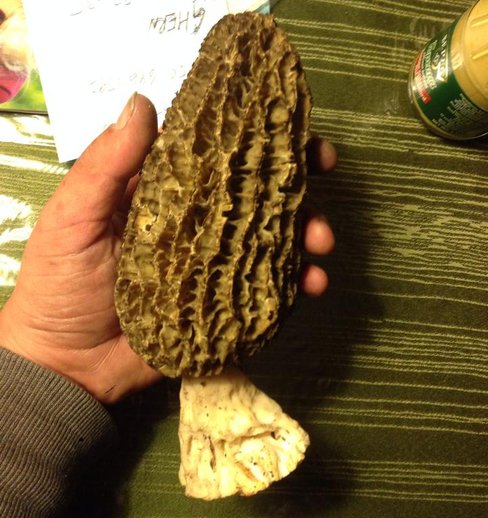
Burn Morel. California.
Unknown species.
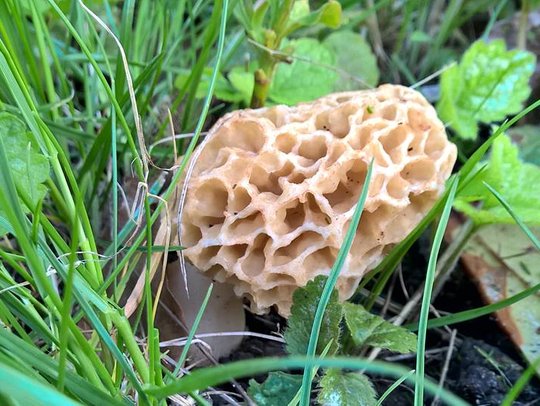
Danish Morchella esculenta.
It is one of the most readily recognized of all the edible mushrooms and highly sought after. Each fruit body begins as a tightly compressed, grayish sponge with lighter ridges, and expands to form a large yellowish sponge with large pits and ridges raised on a large white stem. he fungus fruits under hardwoods during a short period in the spring, depending on the weather, but it is also associated with old orchards, woods, disturbed grounds and burnt areas.
Habitat and distribution
Fruit bodies are sometimes found solitary, but more often in groups, on the ground in a variety of habitats. A preference for soil with a limestone base (alkaline) has been noted, but they have also been found in acid soils. The mushroom is usually found in early spring, in forests, orchards, yards, gardens and sometimes in recently burned areas. In North America, it is sometimes referred to as the "May mushroom" due to its consistent fruiting in that month, but the time of fruiting varies locally, from February to July. It is typically the last morel species to fruit in locales where more than one species are found. For example, in northern Canada and in cooler mountainous regions, morels typically do not appear until June. It has been suggested that the springtime fruiting may be due to their ability to grow at low temperatures to the exclusion of competition, a conclusion later corroborated by experiments correlating spore germination to soil temperatures
the trees associated with morels: pine, elm, tulip, sassafras, beech, ash, sycamore, and hickory.
In North America, it is widely distributed, but especially common in eastern North America and the Midwest. David Arora notes that "large crops can also be found around the bases of dying (but not quite dead) elms attacked by Dutch elm disease." The species has been named state mushroom of Minnesota, and was the first state mushroom of any state.
It can also be found in Brazil and Bulgaria.
Edibility
Morchella esculenta, like all morels, are among the most highly prized of all edible mushrooms. Raw mushrooms have a gastrointestinal irritant, hydrazine, but parboiling or blanching before consumption will remove it. Old fruit bodies that show signs of decay may be poisonous. The mushrooms may be fried in butter or baked after being stuffed with meats and vegetables. The mushrooms may also be dried by threading the caps onto string and hanging them in the sun; this process is said to concentrate the flavor. One study determined the main nutritional components to be as follows (on a dry weight basis): protein 32.7%, fat 2.0%, fiber 17.6%, ash 9.7%, and carbohydrates 38.0%.
Bioactive compounds
Both the fruit bodies and the mycelia of M. esculenta contain an uncommon amino acid, cis-3-amino-L-proline; this amino acid does not appear to be protein bound. In addition to M. esculenta, the amino acid is known to exist only in M. conica and M. crassipes.
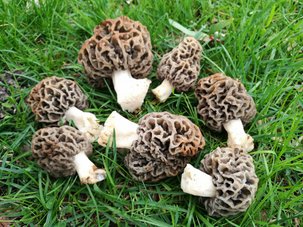
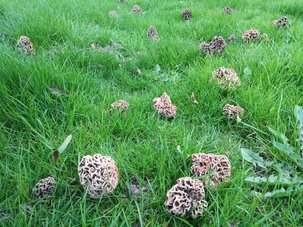
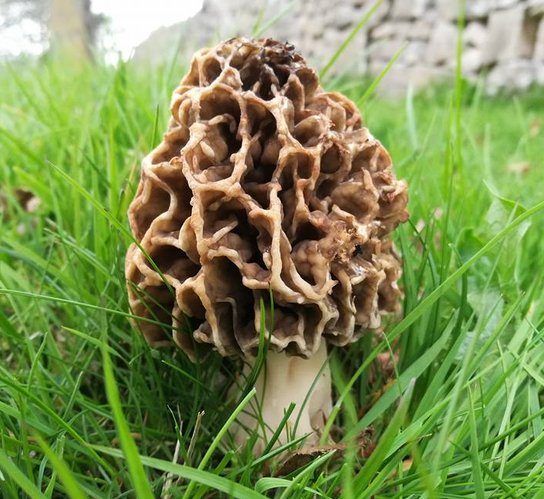
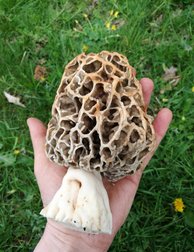
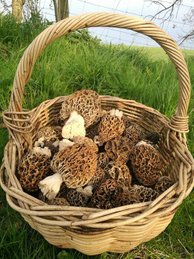
Morchella vulgaris.
Morchella vulgaris is a widespread fungus of the Morchellaceae family (Ascomycota). It was originally described in 1801 as a form of the common yellow morel (Morchella esculenta) by mycologist Christiaan Hendrik Persoon, but was later recombined as a distinct species by Samuel Gray.
Owing to its high morphological plasticity, its taxonomical status had long been in flux, sometimes treated as a variety of, or conspecific to Morchella esculenta, while at the same time several forms and varieties of M. vulgaris itself have been described. An extensive phylogenetic and nomenclatural study by Richard and colleagues in 2014, confirmed the status of Morchella vulgaris as a distinct species, and resolved several of its synonymities.
This species is characterised by the predominantly grey colours of its cap and "blistered", highly irregular appearance of its ridges and pits.
I nutritious soil in gardens, deciduous forests and parks. Especially related to elm.
Pretty rare and especially in areas with significant lime impact
Antioxidant activity of two wild edible mushrooms (Morchella vulgaris and Morchella esculanta)
The ethanol extracts of Morchella vulgaris (EEMV) and Morchella esculanta (EEME) were analysed for their antioxidant activities in different systems including reducing power, free radical scavenging, superoxide anion radical scavenging, total antioxidant activity, and metal chelating activity. EEMV and EEME had similar reducing power, free radical scavenging, superoxide anion radical scavenging, hydrogen peroxide scavenging, and metal chelating activity at concentrations of 50, 100, and 150 microg/mL. These various antioxidant activities were compared to standard antioxidants such as butylated hydroxyanisole (BHA), butylated hydroxytoluene (BHT), and alpha-tocopherol. The percent inhibition of different concentrations of EEMV on peroxidation in the linoleic acid system was 85 and 87 % respectively, which was greater than that of 100 and 250 microg/mL of alpha-tocopherol (50 and 77%, respectively) and similar to 250 microg/mL of BHA (85, 87%, respectively). The percent inhibition of different concentrations of EEME on peroxidation in the linoleic acid system was 80 and 87 % respectively, which was greater than that of 100 and 250 microg/mL of alpha-tocopherol (50, 77%) and similar to 250 microg/mL BHA (87%). On the other hand, the percent inhibition of 100 and 250 microg/mL of BHT was 97 and 99%, respectively. In addition, the total phenolic compounds in EEMV and EEME were determined as gallic acid equivalents.
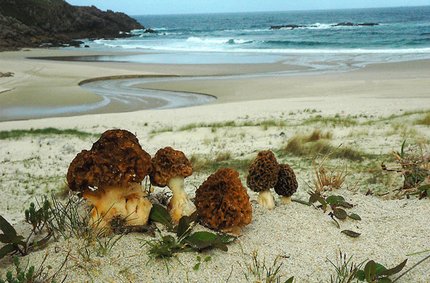
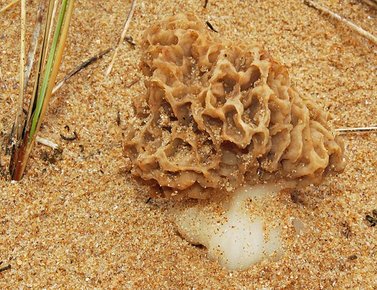
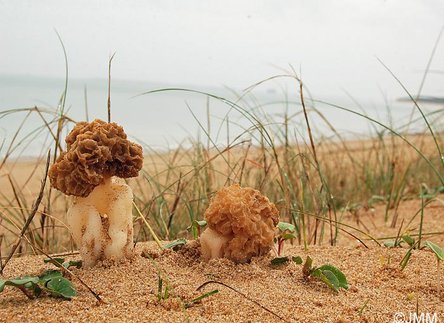
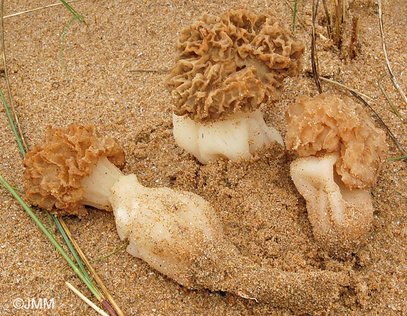
Morchella Dunensis
a species of fungus in the family Morchellaceae (Ascomycota). It was first described as a form of Morchella esculenta by Castañera and colleagues in 1996,[1] but was later recombined as a distinct species by Clowez.[2] In a 2014 study by Richard and colleagues, the authors concluded that the taxon was conspecific to Morchella vulgaris, due to its close phylogenetic proximity to the latter.[3] However, following increased molecular sampling and the testing of an isoparatype collection by Loizides and colleagues in 2016, it was revealed that M. dunensis is indeed very closely related to, but phylogenetically distinct from M. vulgaris.[4] This study also showed that the taxon Morchella andalusiae is phylogenetically identical and therefore a later synonym of M. dunensis.
Morchella dunensis is notable for its xerophilic, Mediterranean ecology and distribution, often found on coastal dunes and bare, well-drained soil.
